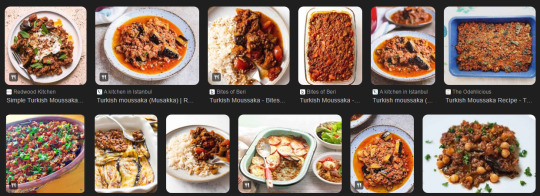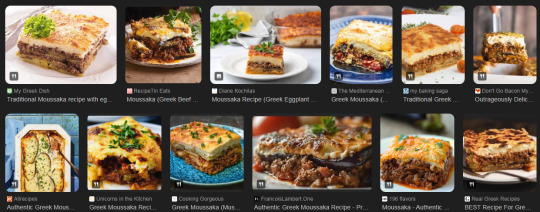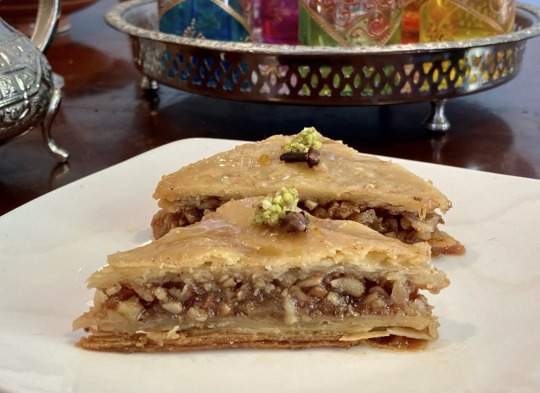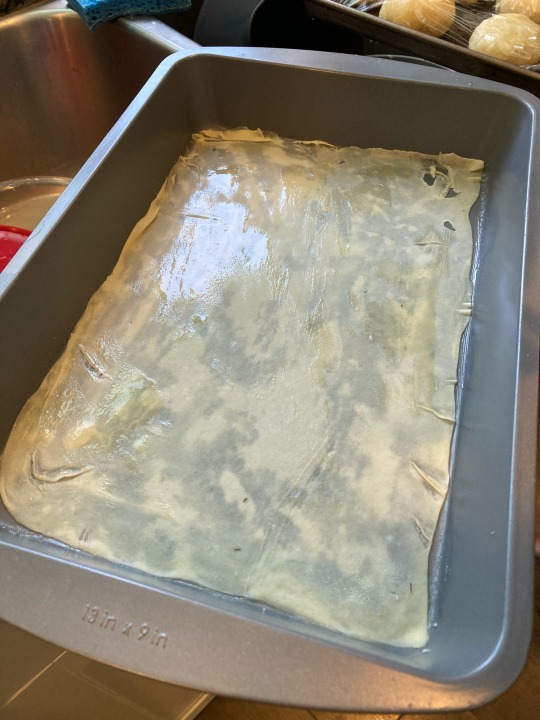#Greek baklava recipe
Explore tagged Tumblr posts
Text
Craving for the delightful taste of Turkish baklava? Look no further! Buy Turkish baklava online from Melek's Baklava & More and experience the melt-in-your-mouth goodness of this sweet treat.
#Homemade turkish desserts#Delicious turkish recipes#Gluten free turkish delight#Baklava baklava#Greek baklava recipe#Classic walnut baklava
0 notes
Text

Easy Homemade Frozen Yogurt
#easy#homemade#frozen yogurt#yogurt#froyo#food#summer#dessert#no bake#honey#recipe#honeycomb#baklava#cherry#greek yogurt#ice cream#whatsgabycooking
196 notes
·
View notes
Text

Baklava Custard Tart
#baklava#sweet#dessert#custard#tart#tarts#custard tart#custard tarts#recipe#recipes#onegreenplanet#walnuts#pistachios#pistachio#maple#maple syrup#filo#phyllo#turkish#middle east#middle eastern#greek#greece
27 notes
·
View notes
Photo

European - Greek Baklava Recipe Each and every person will enjoy the sweet Greek dessert known as baklava, which is made of phyllo dough layered with honey and nuts.
0 notes
Photo

Greek Baklava Recipe Each and every person will enjoy the sweet Greek dessert known as baklava, which is made of phyllo dough layered with honey and nuts. 1 pound chopped nuts, 1 teaspoon vanilla extract, 1 cup butter, 1 teaspoon ground cinnamon, 1 package phyllo dough, 1/2 cup honey, 1 cup water, 1 cup white sugar
0 notes
Photo

Recipe for Chocolate Baklava This chocolate version of baklava is a typical Greek sweet. Despite being simple to make, it appears as though you toiled for hours. It looks fantastic and tastes great. 1 teaspoon butter, 1/2 cup white sugar, 2 ounces semisweet chocolate, 3/4 cup white sugar, 1 pound phyllo dough thawed, 1 pound pecans finely chopped, 3/4 cup orange juice, 1/2 cup honey, 1/2 cup water, 1.5 teaspoons ground cinnamon, 8 ounces dark chocolate finely chopped, 2 tablespoons lemon juice, 1.25 cups unsalted butter melted
0 notes
Photo

Recipe for Greek Baklava Baklava uses phyllo dough stacked with honey and nuts to make a sweet Greek dessert that everyone will love.
0 notes
Photo

European - Greek Baklava Each and every person will enjoy the sweet Greek dessert known as baklava, which is made of phyllo dough layered with honey and nuts.
0 notes
Photo

Chocolate Baklava This chocolate version of baklava is a typical Greek sweet. Despite being simple to make, it appears as though you toiled for hours. It looks fantastic and tastes great.
0 notes
Photo

Greek Baklava Baklava uses phyllo dough stacked with honey and nuts to make a sweet Greek dessert that everyone will love.
0 notes
Photo

Cuisine - Greek Baklava Baklava uses phyllo dough stacked with honey and nuts to make a sweet Greek dessert that everyone will love.
1 note
·
View note
Text
The Mediterranean region is renowned for its rich cultural history and culinary heritage. Central to this culinary wealth is baklava, a sweet delight that effortlessly bridges the gastronomical divide between Greece and Turkey.
#Gluten free turkish delight#Baklava baklava#Greek baklava recipe#Classic walnut baklava#Vegan turkish delight#Tahini halva buy online
1 note
·
View note
Text
Leave it to Sephardic Jews to make even a pedestrian dish — the ubiquitous matzah brei, a mash-up of fried matzah and egg — into something sublime.
In his landmark book “The Sephardic Kitchen“ published in 1996, Rabbi Robert Sternberg introduced many of us to the flavors and pleasures of Sephardic Jewish cuisine. Masa Tiganitas is a Passover recipe of the Greek Jews — “tiganites” is the Greek word for pancakes and, according to Sephardic cook and author Jennifer Abadi, tiganitas is related to the word for “fried.” Masa Tiganitas is also a dish enjoyed by Italian Jews during Passover.
In Sternberg’s version, matzah squares are soaked in milk, dipped in a combination of egg and yogurt and then fried in oil. As opposed to matzah brei, or bumelos de masa, the matzah in Sternberg’s recipe is not crushed. They are left whole, dunked, fried and then sweetened with a drizzle of honey or arrope (a syrup made of grapes), and topped with a sprinkling of walnuts. Think fried matzah meets baklava. I am in love.
189 notes
·
View notes
Text
One of my favorite headcanons is Will and Hannibal running away to Greece to a not so touristic island. Imagine them getting a small house 5 minutes away from the beach. Imagine Hannibal going to every fish market as early as possible while Will is complaining that he needs sleep and cuddles. It would be peaceful for them both. No one would destroy the harmony of the island or of the villagers, they would take care of that. Will would finally get his own fishing boat and Hannibal would make baklava and wait for him at home. They would often argue about the fact that Will spends too much time outside on the sea when it's way too sunny. He would get sun burnt and sun stroked and Hannibal would take care of him and double the amount of sunscreen that he puts on Will every morning in spite of his complaints. They would own a little garden where they would grow olives, oranges and oleanders together. It's their own little thing that they are growing together. Will also adopts enough cats and dogs for a lifetime. Even though they are not are not getting too close to the villagers, the villagers love them for some reason. Maybe because Will is always helping when someone's boat is not working. Or maybe because Hannibal has shared food recipes with the wives whose husbands Will is helping. They would often cook together which is great for Hannibal cause he can learn new greek recipes. Life is simple and good. It's the break they both deserve.
255 notes
·
View notes
Note
Hey, question: what are your thoughts on baklava? Is it turkish or greek?
It's not a matter of opinion, it's a matter of facts and the lack of them. The answer to this is normally an one-liner but I would like to give some context because there are foreign people out there who don't understand these feuds.
The one-liner is that the origins of the baklava are unknown.
Now the context: It is funny that what you will constantly hear is the "turkish vs greek" discourse when in actuality baklava is a traditional pastry in at least a dozen more countries in the Balkans, the Middle East and South Caucasus. The reason the discourse always zooms in in these two countries is because of their historically tense relations, which makes nationalists from these places channel their frustrations even in the pettiest of topics. Another reason is that this is a region which has nurtured numerous multi-ethnic empires but Turkey and Greece are the countries which are typically the most connected to these imperial pasts.
We do not know who the cook who came up with the baklava in the Ottoman empire was or to which of the various ethnic communities of the empire they belonged. We know for a fact that baklava's name is Turkish because this was the official language of the empire. Some turkish nationalists treat the turkish name as proof but this is not a good enough reasoning in an imperial context because everything is almost always popularised via the first language of an empire. With the same reasoning, we could say that since the basis of the baklava is the phyllo (filo) dough which is a Greek word, then baklava is a turkish sweet that is half-Greek because it has a Greek basis? These things are unserious.
We also do not know whether that first cook in the Ottoman Empire created the pastry out of thin air or was heavily inspired or was copying a pastry that was already a known delicacy in these regions before the establishment of the Ottoman Empire. Actually, we know that there was a suspiciously way too similar pastry in the Byzantine Empire, named "koptoplakýs¨, a Greek name corresponding to the official language of the Byzantine Empire. We still don´t know if koptoplakys was purely a Greek recipe or it was first made by one of the other Byzantine ethnic groups or it was also inspired by something else prior to it. Several speculations place the origins of baklava and that of koptoplakys to a variety of regions, such as Ancient Greece, Armenia, the Assyrian Empire and more.
The point is that since all these regions of the Balkans, Anatolia and the Middle East were parts of empires, various ethnicities cohabitating in the same place, in the same ecosystem with the same produce, even if this coexistence was not exactly dreamy, it is natural that all these people pretty much ate similar or the same foods and such foods with "controversial" origins are genuinely part of their culinary heritage. There's no "stealing" when it comes to regular everyday things massively consumed by people living together. It's a pastry. It's not some sacred, religious or national symbol. It's a pastry, traditional and with historical presence throughout most of the Eastern Mediterranean.
Like Farya Faraji correctly says, if anything, the differences were regional and not national, since nation states are a very recent development in world history. Meaning, all these countries make the baklava but you may notice slight differentiations in each country / region's version. The standard Turkish baklava is made with pistachios. The standard Greek baklava is made with walnuts. A baklava I had in Montenegro had a lot of lemon zest in it, which definitely is not a thing in Greece. Spices can vary too.
Also, sometimes there is so much discourse about dishes with the same name when in fact the dishes are not even the same. For example, turkish and greek moussakas, another huge discourse, are literally two different dishes!
Turkish mussaka:

Greek mussaka:

(Needless to say various types of mussakas are present throughout the aforementioned regions as well, again.)
"Yes but the similarities" the similarities can be found in literally all neighbouring regions in the world, let alone in places where different ethnicities have been crammed upon each other in empires for centuries. It's inescapable and you sometimes merge so much you cannot tell who started what. (Unless in cases when we DO know thanks to documented history. Then it's a HUGE no-no to confuse or conflate different neighbouring cultures. This is often very important when it comes to actually serious things like languages, religions, historical incidents instead of... nuts and doughs.)
If you are concerned what you should define it as, simply say "I'm having an x style baklava", x being whichever nation you're getting the pastry or the recipe from. Hope that helped.
#food#history#culinary history#world cuisines#mediterranean cuisine#middle eastern cuisine#greco turkish relations#greek cuisine#anon#ask#long text#ottoman empire#byzantine empire#assyrian empire
53 notes
·
View notes
Text

[ID: Two triangles of baklava garnished with ground pistachio and whole cloves, with a silver Moroccan tea set in the background. End ID]
μπακλαβάς / Baklava
Baklava is a layered pastry consisting of a filling of chopped nuts piled between thin sheets of dough and sweetened with syrup. It is of contested and potentially ancient origin, with similar pastries attested in modern-day Turkey, Greece, and Assyria. Today, many regional variations of the pastry exist throughout North Africa and West and Central Asia.
This Greek-style recipe layers a spiced walnut filling between sheets of homemade filo dough, then soaks them in a sugar-honey syrup flavored with cinnamon, clove, and lemon. The resulting pastry is flaky, flavorful, and über-sweet.
Recipe under the cut!
Patreon | Tip jar
Ingredients:
For the dough:
4 2/3 cup (560g) bread flour
1/2 cup + 1 Tbsp (133mL) olive oil
1 Tbsp + 2 tsp red wine vinegar
About 1 - 1 1/3 cup (240 - 320g) lukewarm water
3/4 cup (165g) butter or non-dairy margarine, melted, for brushing
For the filling:
400g walnuts (or hazelnuts, shelled pistachios, and/or blanched almonds)
1/4 cup (35g) breadcrumbs
1 1/2 tsp ground cinnamon (1/2 cassia cinnamon stick)
1 1/2 tsp ground cloves (18 / 1.5g whole cloves)
Greek baklava most commonly uses walnuts, though pistachios are also used. You may experiment with nuts of your choice.
The breadcrumbs help to soak up the syrup evenly and prevent sogginess.
For the syrup:
2 1/2 cups (500g) vegetarian granulated sugar
1 1/2 cups (355mL) water
1/4 cup (80g) agave nectar or honey
1 tsp orange blossom water (optional)
Peel of one lemon
1 cassia cinnamon stick
3 whole cloves
Instructions:
For the dough:
1. Combine flour and salt in a large mixing bowl. Add the vinegar and olive oil and mix to combine.
2. Gradually add a scant cup of water and continue to mix until the dough just comes together. Continue to knead, by hand or with a stand mixer and dough hook attachment, until the dough becomes smooth and elastic, about five minutes. If the dough does not come together, add additional water 1 tsp at a time. The dough should not be sticky.
3. Divide the dough into small balls of about 40g each (for a 13" x 9" pan). You may decide to make the dough balls slightly larger if you’re a beginner at working with thin dough.
4. Coat each dough ball with some olive oil and cover. Allow to rest for at least an hour, to allow gluten to form and facilitate rolling out later.
For the syrup:
1. Scrub a lemon thoroughly and remove the outer layer of peel with a knife or vegetable peeler. Heat sugar, water, lemon peel, cinnamon, and cloves in a large pot over medium heat until simmering. Stir to dissolve sugar and continue to simmer for about 5 minutes.
2. Remove from heat and stir in honey and orange blossom water. Allow to cool to room temperature, then refrigerate.
For the filling:
1. Blanch almonds by boiling them for about a minute, draining, and pinching gently to remove their skins. Shell pistachios. Chop nuts, or use a food processor, to achieve a coarse grind (you don't want a powder!).
2. Toast and grind whole spices, if using. Combine nuts with breadcrumbs and spices in a mixing bowl and set aside.
To assemble:
Baklava is made by interspersing thin sheets of dough with butter and nut filling to create flaky layers. Several sheets of dough will be needed at the top and bottom to prevent the weight of the nuts from causing the pastry to collapse. Some cooks add all of the nut filling between two groups of filo dough, while others intersperse the nuts throughout.
1. Melt margarine in a small saucepan or in the microwave. Using a pastry brush, coat the bottom and sides of a 9 x 13" baking dish in margarine.
2. On a lightly oiled surface, roll out one ball of dough into a rectangle a little larger than the bottom of your baking dish (it will relax as it transferred). Place the sheet in the bottom of the dish, gently stretching it into the corners. Don't worry too much about small holes—there will be many layers!

3. Gently drizzle and brush melted margarine over the sheet of dough.
4. Repeat this process 4 more times, for a total of 5 sheets interspersed with margarine. I placed each sheet on top of the previous one on the counter and waited to transfer them to the pan until I had rolled out all four. You may need to re-oil your working surface as you go.
5. Add just enough nut filling mixture to form a thin layer.
6. Roll out another two sheets of dough and brush them with margarine as before. Add another layer of nuts. Repeat until the nut mixture is gone, making sure to reserve at least five balls of dough for the top.

7. Roll out and place the remaining balls of dough and brush them with margarine as before.
8. Refrigerate for 10-15 minutes to make the baklava easier to cut. Using a sharp knife, cut the baklava into diamonds by cutting in lines diagonally in one direction, and then diagonally in another direction to form points at an acute angle; or, form triangles by cutting lengthwise and then widthwise to form squares, and then diagonally to cut those squares in half. Stick a whole clove in the center of each piece of baklava, if you like.
9. Bake at 300 °F (150 °C) for an hour to an hour and a half, until the top of the pastry is golden brown.
10. Remove from the oven and allow to cool for about 10 minutes. Pour the cooled syrup evenly over the surface of the baklava. Don't add the syrup warm, or it may make the baklava soggy!
11. Allow the syrup to absorb for several hours, or overnight.
180 notes
·
View notes